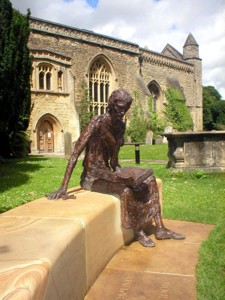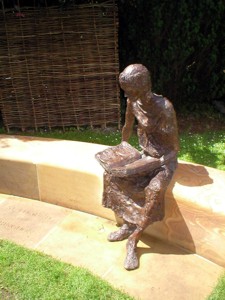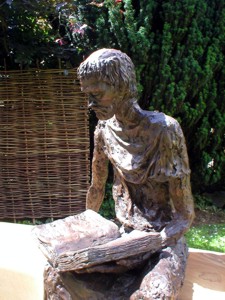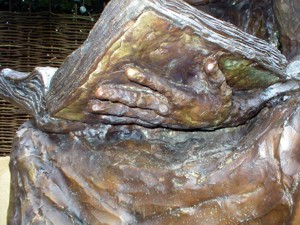ST. EDMUND OF ABINGDON
 A life-sized
bronze on a 4m curved Yorkstone seat and paving commissioned for St.
Edmund Hall, Oxford, unveiled in June 2007 by the Chancellor of the
University, Lord Patten. The
brief was to produce a sculpture that represented the college’s patron
saint, and encapsulate the friendly, intimate atmosphere of the college
today.
A life-sized
bronze on a 4m curved Yorkstone seat and paving commissioned for St.
Edmund Hall, Oxford, unveiled in June 2007 by the Chancellor of the
University, Lord Patten. The
brief was to produce a sculpture that represented the college’s patron
saint, and encapsulate the friendly, intimate atmosphere of the college
today.
Objective
Making
a sculpture of a figure from the distant past is a little like writing
an historical novel. You gather as many facts as are available, form an
opinion about the possible appearance and personality of the person you
are dealing with, and use a good deal of imagination to produce an image
that is necessarily subjective.
We
know little of Edmund’s appearance except that he was bearded and would,
because of his extreme asceticism, have been emaciated. The earliest
representation of him (in St. Michael’s Church, Oxford) was produced
some fifty years after his death, and is in any case, like others of
him, a typical, stylized representation that could be any bishop at
almost any time. He is standing, in bishop’s clothing, with his hand
raised in benediction. I wished to move away from this image in order to
try to represent a man with whom I had become increasingly interested.
 In
contrast to his appearance, we know a considerable amount about the
Saint’s personality because of the detailed attestations of his
contemporaries which were a necessary part of the canonisation
procedure. He was an ascetic, who even by the standards of his own time
carried the concept of mortification
of the flesh to extremes. Overburdened by a sense of duty to both man
and God, he often gave way to the importunities of others but did not do
so simply as a matter of course, and was sufficiently strong of
personality to stand up both to the barons and the king to settle a
dispute that was heading in the direction of civil war. He was
charismatic, and his preaching drove many to join the crusades or enter
the cloister. Therefore I had the interesting task of presenting a
considerate yet strong personality within a body wasted away by extreme
asceticism. In addition to that, I wanted to represent the frustrated
scholar; the man who sent his servant to the monks who came to ask him
to become archbishop, with the message, “go away, I’m reading”!
What Edmund really seemed to enjoy most was just to sit and
read, but enjoyment was not a priority for him. So I decided that it
would be an act of kindness to allow him to read at last, the cross
which he brandished whilst preaching and which was so important to him,
pushed back a little from the forefront of consciousness, though still a
real presence. I also felt that a life sized Edmund, sitting and reading
would be appropriate, since he could blend in with and in a sense be
lost amongst the people who would come to surround him. This seemed
fitting for a man who avoided the trappings of authority, refusing to
wear the mitre and gloves of his office, and who was regarded as
friendly and helpful to others, despite huge personal austerity.
In
contrast to his appearance, we know a considerable amount about the
Saint’s personality because of the detailed attestations of his
contemporaries which were a necessary part of the canonisation
procedure. He was an ascetic, who even by the standards of his own time
carried the concept of mortification
of the flesh to extremes. Overburdened by a sense of duty to both man
and God, he often gave way to the importunities of others but did not do
so simply as a matter of course, and was sufficiently strong of
personality to stand up both to the barons and the king to settle a
dispute that was heading in the direction of civil war. He was
charismatic, and his preaching drove many to join the crusades or enter
the cloister. Therefore I had the interesting task of presenting a
considerate yet strong personality within a body wasted away by extreme
asceticism. In addition to that, I wanted to represent the frustrated
scholar; the man who sent his servant to the monks who came to ask him
to become archbishop, with the message, “go away, I’m reading”!
What Edmund really seemed to enjoy most was just to sit and
read, but enjoyment was not a priority for him. So I decided that it
would be an act of kindness to allow him to read at last, the cross
which he brandished whilst preaching and which was so important to him,
pushed back a little from the forefront of consciousness, though still a
real presence. I also felt that a life sized Edmund, sitting and reading
would be appropriate, since he could blend in with and in a sense be
lost amongst the people who would come to surround him. This seemed
fitting for a man who avoided the trappings of authority, refusing to
wear the mitre and gloves of his office, and who was regarded as
friendly and helpful to others, despite huge personal austerity.
 (My
research into the personality and appearance of St. Edmund are based
principally on two books by C.H. Lawrence: The Life
of St Edmund by Matthew Paris and St Edmund of Abingdon, a
study of Hagiography and History, complemented by information
from J.N.D. Kelly’s St
Edmund Hall.)
(My
research into the personality and appearance of St. Edmund are based
principally on two books by C.H. Lawrence: The Life
of St Edmund by Matthew Paris and St Edmund of Abingdon, a
study of Hagiography and History, complemented by information
from J.N.D. Kelly’s St
Edmund Hall.)
 A life-sized
bronze on a 4m curved Yorkstone seat and paving commissioned for St.
Edmund Hall, Oxford, unveiled in June 2007 by the Chancellor of the
University, Lord Patten. The
brief was to produce a sculpture that represented the college’s patron
saint, and encapsulate the friendly, intimate atmosphere of the college
today.
A life-sized
bronze on a 4m curved Yorkstone seat and paving commissioned for St.
Edmund Hall, Oxford, unveiled in June 2007 by the Chancellor of the
University, Lord Patten. The
brief was to produce a sculpture that represented the college’s patron
saint, and encapsulate the friendly, intimate atmosphere of the college
today. In
contrast to his appearance, we know a considerable amount about the
Saint’s personality because of the detailed attestations of his
contemporaries which were a necessary part of the canonisation
procedure. He was an ascetic, who even by the standards of his own time
carried the concept of
In
contrast to his appearance, we know a considerable amount about the
Saint’s personality because of the detailed attestations of his
contemporaries which were a necessary part of the canonisation
procedure. He was an ascetic, who even by the standards of his own time
carried the concept of (My
research into the personality and appearance of St. Edmund are based
principally
(My
research into the personality and appearance of St. Edmund are based
principally